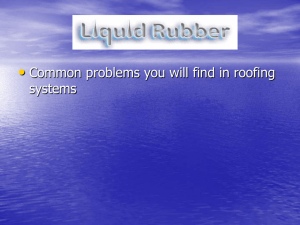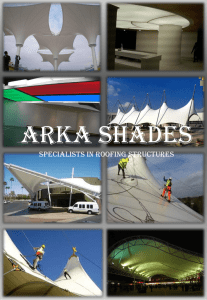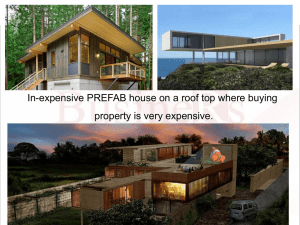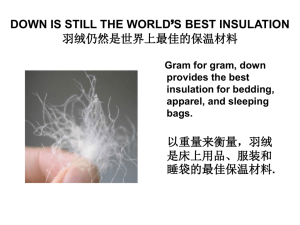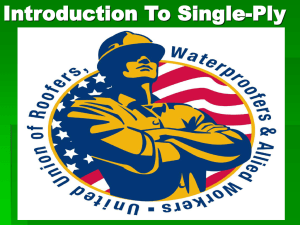Lecture 21
advertisement
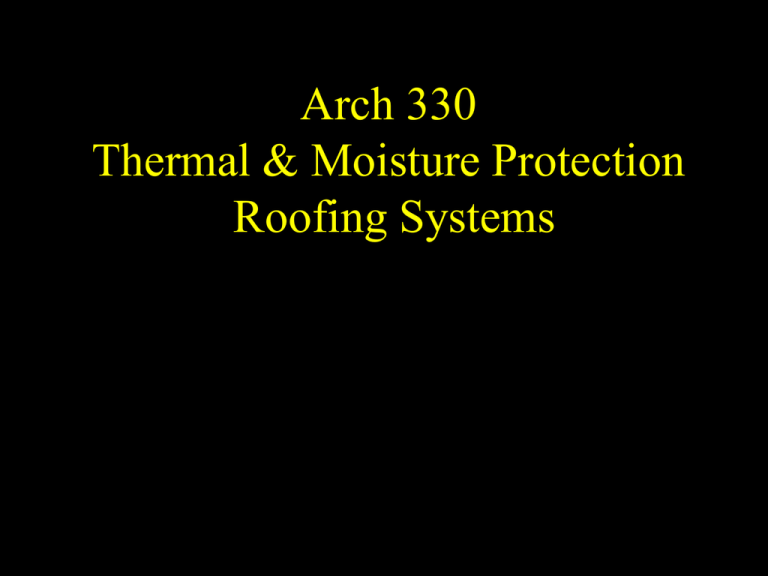
Arch 330 Thermal & Moisture Protection Roofing Systems Roofing Systems 073000 Steep Slope Roofing Shingles and Shakes Roof Tiles Natural Roof Coverings 074000 Roofing and Siding Panels Roof and Wall Panels Siding 075000 Membrane Roofing 076000 Flashing & Sheet Metal 077000 Roof and Wall Specialties and Accessories Division 7 078000 Fire and Smoke Protection 079000 Joint Protection Joint Sealants and Expansion Control Low Slope - Disadvantages • water drains slowly • standing water can cause deterioration • structural movement - tear the membrane. Low Slope - Advantages • can cover building of any horz. dimension can serve as • balconies, decks, patios, landscaped gardens. Item Spotted: Flat roof Observations: This is not a good roof design for wet climates. There is constantly puddles of water on the top of this roof. Location: PEB, WSU Campus Name: Kallen Hawthorne ID# 10596914 Steep Slope • drains quickly • can be covered with roofing material of small overlapping units - shingles of wood - slate - artificial composition - tiles of fired clay or concrete - bundles of reeds (thatch). Steep Slope • Thermal expansion / contraction minimized • Movement in structure is minimized - by the ability of small units to move with - respect to one another. • Water vapor vents from the interior through the loose joints in the roofing material. Item Spotted: A combination of a flat and gamble roof Observations: This building has a very interesting skyline because of the combination roof. However if one was to look closely at the picture, one con see puddles of standing water. Location: Smith Gym, WSU Campus Name: Kallen Hawthorne ID# 10596914 LOW SLOPE ROOF (not FLAT) < 3:12 pitch • Min Slope • 1/8” per 1’-0” or 1:100 • 1/4” per 1’-0” or 1:50 Low < 3:12 pitch 3 1/4 12 Roof Slope • Slope Roof to direct water towards drainage points - counter-acting structural deflection. • Depending on size of deck expansion joints should be provided to - control expansion and contraction and - satisfy requirements of membrane. • Membrane should be laid on flat surface. FLAT ROOF - COMPONENTS • DECK • THERMAL INSULATION • VAPOR RETARDER • MEMBRANE • FLASHINGS • DRAINAGE COMPONENTS Deck:Types of structural deck used for low slope roof • • • • Plywood over wood joists Solid wood decking over heavy timber framing Corrugated steel decking Panels of wood fiber bonded together with portland cement • Poured gypsum over insulating formboard • Sitecast concrete and precast concrete Insulating Deck Boards – wood/glass fibers Truss Tee Purlins + slab of gypsum/lt wt conc Thermal Insulation • Below the Deck • Between Deck + Membrane • Above the Membrane Thermal Insulation: Below the Deck • Leaves the deck and membrane exposed to full range of temperature. • Batt insulation of glass fiber or mineral fiber between wood joists - or on top of a suspended ceiling assembly. • Vapor retarder below insulation** (Vapor retarder on warm side of insulation) Insulation: Between Deck and Membrane • Rigid panels of insulation, light weight concrete. • Protects deck from temperature extremes. • Membrane subjected to extreme temperature variations. • Moisture trapped in insulation can damage insulation and deck. • Place vapor retarded on inside of insulation and vent insulation to release moisture. Insulation: Above the Membrane • Membrane protected - extremes of temperature. • Membrane on warm side of insulation - immune to vapor blistering. • Insulation must be a material which is not effected by wet and will not disintegrate - extruded polystyrene board • Insulation board adhered in bed of hot asphalt or laid loose. • Layer of ballast laid over insulation. Insulation: Above the Membrane • Ballast - crushed stone - thin concrete layer factory laminated to upper surface of insulation board - interlocking concrete blocks. • Membrane ages little protected from sunlight and temperature extremes - despite presence of moisture. • Rigid insulation - mechanical fix to deck preferable. Insulation above the Membrane: Other names for this system • Inverted roof • Upside down roof • Protected membrane roof, +- 20years old Vapor Retarder • 2 sheets asphalt saturated roofing felt • In cold climate on warm side of insulation.** • In hot humid climate/with air conditioning on outer side of insulation** Membrane • Built up roof membrane • Single-ply roof membrane • Fluid-applied roof membrane Built-up membrane • 2-4 Layers/ plies of felt asphalt impregnated, bedded in bitumen felt: cellulose fibers/glass fibers +asphalt • Felt laminated in overlapping layers • Layer of aggregate (crushed stone) Built-Up Membrane • Bitumen - asphalt derived • For low pitch roofs - coal tar bitumen or coal-tar pitch used- greater resistance to standing water • Asphalt and coal tar are applied hot • • • • Aggregate Insulation Felt Conc. Deck • • • • Aggregate Felt Insulation x 2 Metal Deck • 4 ply felt + hot asphalt Single Ply Roof membrane • Single layer • More elastic - less cracking/tearing • Fixing: adhesives, ballast, concealed fasteners, mechanical fasteners. • Protective coating Single Ply Roof Membrane • EPDM , synthetic rubber (ethylene propylene diene monomer) • NEOPRENE (polychloroprene) synthetic rubber compound • PVC (polyvinyl chloride) vinyl - thermoplastic compound Single-Ply Membrane Aluminum Faced Single-Ply Membrane Fluid Applied Membrane • domes, vaults, complex shapes • roller or spray gun, applied • several coats - rubbery membrane. Built-Up + Single Ply Ballast • loose stone aggregate • precast concrete blocks. • Ballast holds the membrane in place against wind uplift • Protects membrane from ultraviolet light and physical wear. • Increase the fire resistance of the roof covering. Traffic Decks-walks, terraces, parking – on low slope roof (a) Heavy square paving slabs or stones –open joints on blocks of plastic or conc on roof membrane (b) Open Jointed Paving Blocks on A drainage layer of gravel or porous concrete leveled over the membrane • • Water falls through the joints and is drained away by the membrane below Membrane is not pierced. Structural Standing Seam Metal Roofing for Low Slope Roofs: • Proprietary systems of standing seam metal roofing • Used as low slope roofs - 1/4" in 12 "(1:48). • The folded shape - stiffness - support itself + a normal snow load between purlins without the need for structural deck below. Mechanical Fix Through Insulation to Deck below Hot Application of Layers Stone ballast on Insulation on Membrane Mechanical Fix Steep Slope >3:12 pitch 11.25º 3 12 Steep Slope >3:12 pitch • Drains quickly, • Small overlapping units - Shingles • Expansion and contraction and movement • Water vapor vents Steep Slope Roof – Systems 3 Categories of Covering • Thatch • Shingles – wood, asphalt, slate, clay/conc • Sheet Metal – lead, copper, terne, aluminum Steep Sloped Roof Systems • Typically insulation and vapor retarder installed below the roof sheeting or deck. • Underside of deck is exposed as a finished surface - vapor retarder and rigid insulation above the deck below roofing layer of plywood (nailed over the insulation panels as a nail base for fastening shingles or sheet metal). Insulation Steep Sloped Roof Typically insulation and vapor retarder installed below the roof sheeting or deck. Insulation Steep Sloped Roof Underside of deck is exposed as a finished surface Flashing @ all junctions Thatch • • • • • • Bundles of reeds, grasses or leaves, Labor intensive Highly insulative Attractive Codes limit its use Not fire resistant Shingles Small size unit, applied to roof in overlapping layers - staggered vertical joints • • • • • wood shingles/ shakes asphalt shingles slates clay tiles and concrete tiles. PV – photovoltaic Shingles • Each type of shingle, slate or tile must be laid on a roof deck - that slopes sufficiently to assure leak-proof performance. • Min. slope for each material are specified by the manufacturer and code Wood Shingles: • Thin, tapered slabs of wood, SAWED from short pieces of tree trunk • Grain parallel to the face of the shingle. Wood Shakes • Split not sawn • Rough face texture, • North US - wood shingles/ shakes are Red cedar, White cedar, • Redwood - natural decay resistance. • Wood roof covering moderately expensive, not highly resistant to fire unless pressure treated with fire retardant chemicals. Asphalt Shingles • Asphalt impregnated felt - faced with mineral granules. • Die cut from sheet, typical size 12" x 36". • Slotted twice - smaller unit. • Inexpensive, quick to install, moderately fire resistant. • Expected life time of 15 to 25 years. • Laid on asphalt saturated felt paper in two layers. Slate • Split, trimmed to size and punched or drilled for nailing. • • • • Fire resistant, long lasting, relatively expensive, laid in over lapping layers. Tiles – Clay, Concrete • • • • • • Glazed and unglazed Concrete less expensive than clay roof tile. Typically heavy Durable Highly resistant to fire Expensive in first cost Architectural Sheet Metal Roofing: • Relatively high in first cost • Last for many decades. • Galvanic action should be avoided in the roof installation. • Beware of water run-off also re galvanic action from one metal to another. Seaside, Gulf Coast – The Truman Show Strawbale, Potlatch, Idaho Lead, Copper: Sheet • Used since ancient times. • Self-protecting metal - last many decades. • Installed in sheets using systems of joining and fastening • Maintain water tightness at the seams. • Seams especially standing & batten seams create a strong visual pattern. Lead, Copper: Sheet • Lead oxidizes to a white color. • Copper turns blue-green in clear air, black in an industrial atmosphere. • Chemical treatments and coatings can be applied to preserve a desired color. Other Sheet Metals Aluminum, Zinc Alloys, Stainless Steel Sheet Metal Roofing • Can be used in same way as copper, lead and terne

